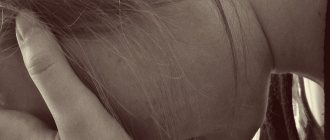Washing in a real bathhouse is a complete relaxation for body and soul. There you can warm up, relax and steam. If you don’t have your own bathhouse, you can always visit a public one. However, for some people, the positive impression after washing is spoiled by the appearance of red spots on the skin. This doesn't happen very often. About 2 out of 10 people notice red spots after a bath. What is this connected with? People who often wash in the bathhouse believe that it is not scary at all, but beginners can be seriously scared. Let's try to figure out why red spots appear on the skin after a bath? Should I be afraid of this and should I run to the doctor as soon as I notice such a reaction?
The appearance of red spots due to high temperature
First, you should figure out what stains may appear after visiting the bathhouse. If they are large and red, then most likely they arose due to the fact that the person warmed up well or took a steam bath. The fact is that in our body there are two types of capillaries: normal and reserve. In normal conditions, blood flow at your usual ambient temperature is approximately the same level, but in a bathhouse, due to exposure to high temperature, it becomes much greater. It is for this reason that the entire skin turns very red. After a person warms up well or steams, blood also begins to flow into the reserve capillaries. However, they are poured late, which is why red spots appear that stand out sharply on the skin.
In this situation, there is no need to panic, because after a while the body will return to normal, and not a trace will remain of the stains.
Aquagenic allergy
26.05.2021
A painful reaction of the skin to water after a shower or being in a pool, swimming in an open body of water is a rare occurrence. The number of people affected by this disease in the world is 50. Experts identify both harmless causes of the disease and quite serious ones.
The body of a person suffering from aquagenic urticaria after interacting with water becomes covered with red, painful, itchy spots. Discomfort appears even after crying, walking in rainy weather, or simple sweating .
Aquagenic urticaria is a painful disease. The instantly appearing rash goes away after some time: when interaction with water is stopped. Careful attention to the problem helps maintain health and eliminate consequences.
What does aquagenic allergy look like?
Against the background of a strong burning sensation, the human body is covered with itchy blisters, which condense into blisters. The rash is small in size and pinkish in color. Symptoms indicate high levels of histamine in the dermis. After bathing, the clinical picture is “visible”: bubbles appear on the chest , neck , armpits and popliteal hollows, on the bends of the elbows.
Why do my eyes turn red after swimming?
Immune cells are located in considerable numbers on the mucous membranes of the human body and on the eyes , including. the eyes come into direct contact with the irritant, an immediate reaction occurs - conjunctivitis. In this case, the skin becomes covered with spots and itches.
Impurities that are part of water are the cause of an allergic reaction . Chlorine irritates the skin instantly. This substance is used everywhere because of its low cost and high efficiency. Allergy sufferers, unlike most people, must exercise caution.
Rules for staying in the water
The water in the pool must be thoroughly cleaned: chlorine byproducts are dangerous. doctors recommend visiting ozonated pools. Hair, skin particles, sweat, urine - all this is pathogenic flora, which, when reacting with chlorine, provokes allergies . If the skin becomes red or itchy, you should take an antihistamine. If reactions get worse, you should consult a doctor .
Itching after shower
Allergies often triggered by cosmetics. Impurities in water can also cause itching. Sometimes all of these symptoms, along with a rash, indicate the presence of polycetomy. This is a benign tumor disease that slows down blood flow in the vessels and forms blood clots: blood supply is disrupted, hypoxia appears.
Replace showering with bathing in settled, non-chlorinated water. Use hypoallergenic products for water treatments. Before swimming in ponds, apply a fat-based cream to your body. Relieve local itching with soothing ointments.
Effective and painless ways to interact with water
Do not use low quality water. To clean flow water intended for drinking, use special filters. For hygiene procedures, use boiled water. Water from natural sources is the safest for swimming.
Published in Allergology Premium Clinic
What to do if red spots appear
As we have already found out, red spots on the body after a bath or sauna can appear due to exposure to high temperature. However, sometimes they may occur not after, but during bath procedures. If you feel discomfort or embarrassment, then you need to follow a few simple steps:
- Leave the steam room for a while, it is best to sit in the relaxation room.
- Drink a glass of water at room temperature.
- Close your eyes, relax, rest for 10-15 minutes.
- After your pulse and heart rate normalize, you can return to the sauna.
Usually these measures are enough for your skin to acquire its usual color. Some people find swimming in a cool pool helps get rid of red spots.
Causes of burns
A burn can occur due to exposure to:
- fire;
- hot liquid or steam;
- hot metal, glass or other objects;
- electric current;
- radiation (x-rays or radiation therapy);
- ultraviolet radiation (sun or solarium);
- active chemicals.
It is worth noting that the causes of burns may be different, but all types of such injuries are classified depending on the degree of damage caused and symptoms:
- First degree. This burn affects only the outer layer of the skin. The injury is characterized by redness, swelling and pain. The victim is given first aid and a short course of treatment is prescribed.
- Second degree. This burn leads to damage not only to the epidermis, but also to the underlying layer - the dermis. The lesion is characterized by redness, whitening or mottled skin, pain and swelling. It is possible to develop blisters from burns and severe pain.
- Third degree. With this type of damage, the fat layer under the skin is affected. Burnt areas of the body become charred, blackened or white. Third degree burns often disrupt the functioning of the nervous and respiratory systems.
First steps to neutralize thermal burns
- remove the victim as far as possible from the heat source;
- If clothing or equipment is smoldering, you should get rid of it immediately. If clothing is stuck to the skin, you must carefully cut it off or remove it;
- apply dry ice or use cold water to the damaged area;
- treat damaged areas of the body with burn ointment;
- In case of serious injuries, call an ambulance.
Neutralization of chemical burns
- Rinse the affected area with a strong stream of water. Under no circumstances should you treat a wound with oil.
- If a burn is caused by quicklime or sulfuric acid, it should be
- treat with a dry cloth, the use of water is unacceptable;
- apply a sterile antiseptic bandage.
There are situations when people get severe burns. Treating them outside the hospital requires special knowledge and skills. If a person does not have them, it is better to immediately consult a doctor.
Quick help
In order to quickly bring your skin back to normal, you can rub a small amount of essential oil into it. You can use: rose or tea tree oil, lavender, cypress, chamomile or geranium oil.
Experts recommend making masks that will quickly help get rid of hated red spots. It is better to use natural ingredients for them, such as oatmeal, potatoes, parsley, and blue clay. A honey mask very effectively cleanses the skin and evens out its color.
Elimination with medication
The use of medications without a doctor's prescription is unacceptable. In order to prescribe medications, you must first conduct a medical examination.
A patient with a similar problem may be prescribed antihistamines, as well as essential oils, which should be applied to the skin in small quantities.
In order to speed up the healing process, you should also limit your consumption of the following foods:
- fatty, smoked, salty and spicy;
- citruses and chocolate;
- semi-finished products and fast food.
Experts' opinions
Experts believe that red spots after a bath or sauna are normal. Their appearance is due to the influence of high temperature and steam on the capillaries. The presence of red spots is not a cause for concern. Continue visiting the sauna if it gives you pleasure. Experts say that bath procedures have truly magical properties. People who prefer to visit a sauna or steam room weekly slow down the aging process, cleanse the body of toxins and impurities, reduce the number of wrinkles, and improve their mood.
Why do some people develop red spots after a bath, while others do not? The fact is that all people are different. Each person's body works differently.
Treatment of scars after burns
If you are interested in how to get rid of the external consequences of a burn, you need to know that in case of serious damage to the skin, the scar will remain in any case. Here you will need the help of a cosmetologist who will help restore the normal appearance of the skin.
Typically, for such an operation, a scar excision technique is used, after which several cosmetic sutures are applied to the tissue. When the sutures are removed, the damaged area is treated with ointments that prevent the formation of new scars on the skin.
For particularly difficult cases, for example, burns from boiling water, the laser resurfacing technique is used. Modern equipment allows you to completely remove scars and achieve perfect skin. If the severity of the burn is insignificant, chemical peeling with fruit acids is recommended.
Allergic reactions
Red spots after a bath may indicate an allergic reaction. It can occur due to the use of cosmetics. It may happen that after a bath, an allergy to the shampoo that you have been using for a long time will appear, because due to exposure to high temperatures, the skin becomes more susceptible to all chemicals.
The cause of red spots and itchy skin can be very hard water or chlorine, which are added for disinfection. For example, you visited a public sauna with a swimming pool, took a good steam in the steam room, and then took a swim. In such places, the water is usually chlorinated, which can cause red spots on your skin. Don't panic. Apply moisturizing milk or cream to the areas where you feel discomfort. If the itching does not go away or gets worse, you should consult a dermatologist.
Sensitive skin.
Sensitivity can be with you almost all your life, or it can appear suddenly.
Symptoms of sensitive skin:
— Excessively whitish tint of the skin; - Tightening sensation after taking a bath; - Irritations that sometimes arise “out of the blue”; — Tendency to form pigment spots; - You periodically experience: burning, swelling, tingling, redness, itching, peeling; — Susceptibility to ultraviolet rays (leading to burns).
- Recommendations. What it is not advisable to do if you are hypersensitive:
- Take an excessively hot bath;
- Rub the skin with a hard washcloth;
- Use scrub or peeling frequently;
- Clean the bathtub with aggressive chemicals
- From various bath foams, gels, soaps - having a hard or “questionable” composition;
- Add salt and/or potent essential oils to the bath.
What is better to avoid:
Beauty tip:
— Buy eco-friendly or natural body cosmetics, without chemical components; — Or try making homemade cosmetics yourself; — Take a bath with herbal infusions. Choose those that will relieve irritation and soothe sensitive skin - Install a main filter for water purification (today this is an excellent solution for any skin type)!
Visiting a public bath or sauna
If red spots on the skin appear after visiting a public bath, then the cause may be an infection. In such a place you can easily catch a fungus or something else unpleasant. When visiting a public bath or sauna, be sure to follow the rules of hygiene and do not forget to take rubber shoes with you. Before sitting on any surface, spread an oilcloth or sheet.
Do not use other people's towels and bath accessories. Some people become covered with red spots after a bath precisely because they did not follow hygiene rules. Be especially careful if you take small children with you, because they are especially susceptible to bacteria and infections.
Treatment after burns
If you receive minor injuries, you can try to neutralize them on your own. If you have knowledge of how to treat superficial wounds, you can handle this yourself.
Ointment or gel for burns from boiling water helps well with kitchen problems. If second or third degree burns have been sustained, hospital treatment is required. It should be done in a clinic under the supervision of doctors. The therapist will recommend how to treat the burn or how to treat a burn with blisters.
Pimples on the face after a bath
Female representatives often note the appearance of acne after visiting the bathhouse. Although bath procedures, in principle, should produce the opposite effect. After washing in the bath, the pores open and cleanse, which has a beneficial effect on the condition and appearance of the skin. So why sometimes acne does not go away, but appears? People themselves are to blame for this because they do not follow basic hygiene rules. During a visit to the steam room, heavy sweating occurs, which is why a person may take someone else’s towel or simply start wiping the sweat from his face with his hands. At this point, it is very easy to introduce bacteria or dirt into open pores.
Bath and skin: general information
So I look at the paintings that depict heroes and young ladies, and I am ready to fight in hysterics, because I do not understand one simple thing. How did they manage to maintain their magical beauty, blooming youth and precious health until old age? Have you ever thought?
Even though I am a man, I would nevertheless like to know the recipe for a healing elixir. Having sifted through the darkness and darkness of information, I realized that there was no magic drink. It's all because of the steam room. Thanks to regular procedures, they managed not only to preserve, but also to increase the “gifts” given by Mother Nature.
The benefits of a bath for the skin
I think you know that the steam room has a beneficial effect on the entire body. Do you know how a bath affects the skin? No? Great. Now I will tell you how a bath is useful for the skin. Bath procedures:
- actively open pores;
- effectively cleanses the skin of any kind of impurities, as well as dead skin cells;
- effectively remove excess fluid;
- effectively rid the skin of harmful substances;
- normalize the functioning of the sebaceous glands, due to which dry skin is moisturized after a bath, and oily skin is dried out;
- stimulate the production of collagen and elastin fibers;
- smooth out wrinkles;
- slow down the process of biological aging;
- maintain water balance at the proper level;
- eliminate acne and prevent the problem from occurring in the future;
- allow beneficial substances to easily penetrate the skin, saturating it with vitamins, minerals and amino acids;
- accelerate metabolic processes, which has a beneficial effect on the skin;
- make the skin soft and radiant.
I won’t talk about all the benefits, as it would be too long.
I will list the properties that bath procedures have. The steam room is famous for the following properties:
- cleansing;
- nutritious;
- moisturizing;
- restorative;
- anti-inflammatory;
- protective;
- softening;
- rejuvenating;
- strengthening;
- activating;
- stimulating;
- regenerating;
- antibacterial;
- antiseptic.
Thus, the steam room is excellent for different skin types. The sauna is good for dry skin, oily skin, combination skin, and normal skin. There are no restrictions regarding skin type.
Useful tips
If you have a lot of pimples on your face, then it may be better for you to avoid bath treatments. Under the influence of high temperature and hot steam, the situation may worsen.
When visiting a bathhouse or sauna, always listen carefully to your body. Red spots on the skin are not considered dangerous, but if you experience any other unpleasant symptoms after visiting the bathhouse, it is better to seek advice from a specialist.
You should not overload your body and sit in the steam room for a long time, because this can cause great harm to your health. After you've had a good warm-up or steam, visit the relaxation room and give your body a chance to cool down and rest.
Close location of capillaries to the surface of the skin
Another reason for redness. From irritation and hot water, the vessels dilate and become more visible than usual.
- Recommendations:
- We exclude: rubbing the skin with a hard washcloth, cosmetic scrubs and peels, sudden changes in water.
- If you are a fan of high temperatures, then redness will appear again and again. Take a bath with moderate or even slightly cool water temperature. Reduce the temperature gradually; you can use a special thermometer to control the process. For example, reduce by 1 degree every month. Important!
Lying in cool water for a long time is, of course, not recommended, here you focus on comfort, usually it is about 37-40 degrees. But for the shower you can use less. But remember that a cold shower is already hardening, and a special approach is needed here.
Remedies for burns
How to treat a burn, and what kind of surgical assistance can be provided independently in the field or at home?
The use of creams such as Levomikol or Rescuer is guaranteed to help with minor injuries, such as briefly touching a hot pan. Dexpanthenol works very well for first degree burns. If the degree of damage is more serious, creams can only be used as a preventive measure and there is no point in relying on them.
Anti-burn products such as sprays or gels - for example, Burnshield Anti-burn Hydrogel - are more effective because they are dispersed and are better absorbed by the skin. These drugs combine two functions - anti-inflammatory and analgesic.
Buy
Buy
Buy
There is another type of treatment - special anti-burn dressings. They are recommended when the patient needs to be outdoors. Such dressings prevent dirt and dust from entering the wound.











